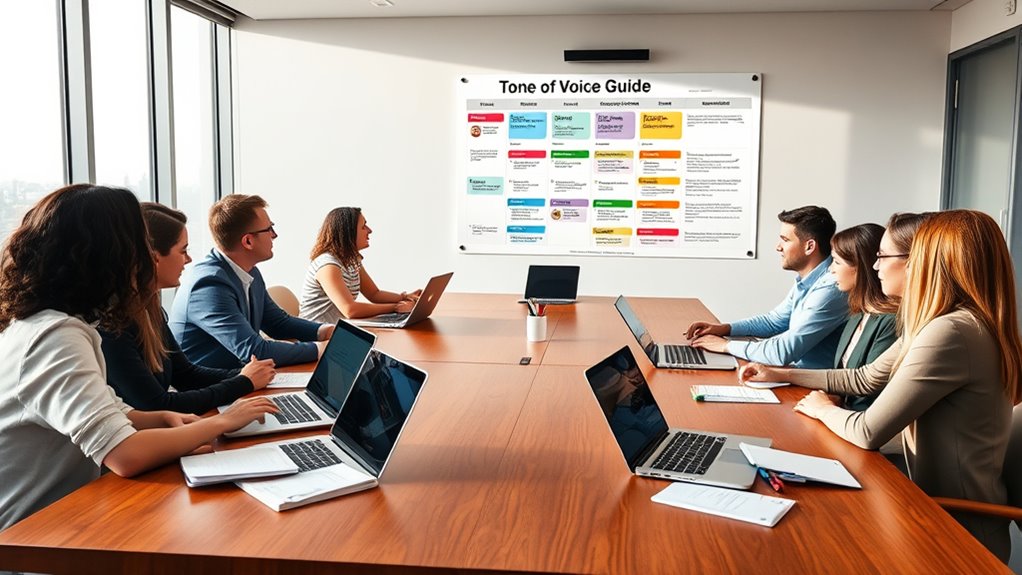To craft a unique tone of voice guide, start by defining your brand’s core traits to guarantee your messaging feels authentic. Analyze your audience’s preferences, expectations, and demographics to tailor your style effectively. Establish clear guidelines for language, tone, and style, including vocabulary and punctuation. Incorporate practical examples and scenarios to guide consistent application across channels. Keep refining your approach over time to stay aligned with your evolving brand and audience, and discover more insights as you continue.
Key Takeaways
- Define your brand’s core personality traits and values to establish authentic tone guidelines.
- Analyze audience demographics and preferences to tailor the tone and language style effectively.
- Develop clear voice attributes, style preferences, and consistent terminology to ensure message uniformity.
- Incorporate cultural insights and practical scenarios to adapt tone appropriately across channels.
- Regularly review and update your tone guidelines to maintain relevance and authenticity.
Understanding Your Brand’s Core Identity

Have you ever wondered what truly sets your brand apart? It starts with understanding your brand’s core identity. Your brand personality shapes how you communicate and influences your tone of voice. Define traits that reflect your values, whether it’s friendly, professional, or innovative. This clarity guarantees your messaging remains consistent across all channels, reinforcing your brand’s identity. When you know your core, you can craft a tone that feels authentic and resonates with your audience. Message consistency isn’t just about repetition; it’s about maintaining a unified voice that builds trust and recognition. By understanding what your brand stands for, you create a foundation for a compelling, memorable tone of voice that truly represents your business. Recognizing your brand’s core traits helps you tailor your messaging to match your audience’s expectations and preferences. Additionally, exploring content strategies rooted in your core identity can further strengthen your brand’s voice and engagement.
Analyzing Your Audience’s Preferences and Expectations

To tailor your tone effectively, you need to understand who your audience is and what they expect from your brand. Identifying audience demographics helps you recognize their preferences and communication styles. By grasping their tone expectations, you can craft messages that resonate and build stronger connections. Additionally, understanding the specific dessert types relevant to your content can further refine your messaging to better inform and engage your readers. Recognizing self-awareness as a key component of effective communication can also enhance how you connect with your audience and adapt your tone accordingly. Being aware of indoor air quality concerns can help you tailor your messaging to address their health priorities and needs. Understanding narcissistic traits can also help you anticipate your audience’s reactions and craft more empathetic communication strategies.
Identifying Audience Demographics
Understanding your audience’s demographics is essential for crafting a tone of voice that resonates. By conducting demographic analysis, you gain insights into age, gender, location, and education levels, helping you tailor your messaging effectively. Audience segmentation allows you to categorize your audience based on shared traits, ensuring your tone aligns with their preferences. For example, a younger audience may respond better to casual language, while a professional demographic prefers formal communication. Knowing these details helps you avoid a one-size-fits-all approach and craft a voice that feels authentic and relatable. Regularly updating your demographic analysis guarantees your tone remains relevant as your audience evolves. Additionally, understanding environmental impact and the sustainability aspects of hydrogen fuel cells can help you tailor messages that emphasize eco-friendly benefits. Recognizing the popularity of pinball machines can also inform your engagement strategies, ensuring your communication stays aligned with current trends. Incorporating knowledge of crochet styles for locs can inspire creative and trendy messaging that appeals to fashion-forward audiences. Ultimately, understanding your audience’s demographics empowers you to connect on a deeper level and foster stronger engagement, especially when considering safety standards for newborn products. Incorporating insights from healthy fruit juice varieties can further refine your messaging to appeal to health-conscious segments.
Understanding Tone Expectations
Analyzing your audience’s preferences and expectations is essential for shaping a tone of voice that genuinely resonates. To do this effectively, consider their preferred emotional tone—whether they respond better to warmth, professionalism, or enthusiasm. Pay attention to their humor style; some audiences appreciate witty banter, while others prefer subtle humor or none at all. Understanding these nuances helps you craft messaging that feels authentic and engaging. You should also identify the level of formality your audience expects and how much personality to infuse into your content. By aligning your tone with their emotional needs and humor preferences, you create a connection that encourages trust and loyalty. Recognizing the importance of health benefits and how they influence consumer interests can further refine your messaging approach. Incorporating relevant back pain relief tips and insights can make your content more valuable to your readers. Additionally, understanding the features of the ultimate heat pump can help you tailor your messaging to emphasize reliability and efficiency. Knowing about electric dirt bike horsepower and its performance capabilities allows you to highlight technical features that resonate with enthusiasts. This insight guarantees your communication hits the right notes, making your voice stand out confidently.
Defining the Voice Attributes That Reflect Your Brand

Have you ever wondered what makes a brand’s voice truly stand out? It all begins with defining your voice attributes that mirror your brand personality. These attributes serve as guiding principles, shaping how your brand communicates and connects. Focus on traits like warmth, professionalism, or playfulness, depending on your audience and values. By clearly identifying these qualities, you create emotional resonance that fosters trust and loyalty. Your voice should feel authentic and consistent across all touchpoints, helping your audience recognize and relate to your brand instantly. When your voice attributes align with your brand personality, they form a compelling identity that engages emotionally and leaves a lasting impression. Clear, deliberate voice attributes are the foundation of a memorable, impactful brand presence.
Creating Clear and Consistent Language Guidelines

You need clear language guidelines to make certain your message stays consistent and easily understood. Start by defining core vocabulary that reflects your brand, so everyone uses the same terms. Then, set style preferences and tone rules to keep your communication uniform across all channels. Incorporating consistent terminology ensures your messaging remains coherent and recognizable to your audience. Additionally, referencing industry-specific standards, such as the optimal angles for pinball machines, can help maintain technical accuracy and clarity in your communication. Establishing a shared understanding of key concepts related to your content, like branding terminology, further enhances message clarity and effectiveness. Recognizing the influence of cultural impact on communication strategies can also help tailor your tone to resonate better with your target audience.
Defining Core Vocabulary
How can you guarantee your brand’s voice remains consistent across all communications? The key is defining your core vocabulary. Choose words that reflect your brand’s personality and avoid jargon that might confuse your audience. Clear, simple language fosters emotional resonance, helping your message connect deeply. Establish guidelines on preferred terminology, tone, and phrasing, so everyone uses the same language. This consistency builds trust and makes your brand more recognizable. Remember, avoiding jargon isn’t about dumbing down your message but about making it accessible and authentic. When your team understands and applies these core words and phrases, your voice stays steady across channels. Consistent language also involves understanding the visual language that complements your words, ensuring a unified brand presence. This creates a cohesive experience that resonates emotionally with your audience, strengthening your brand identity over time. Incorporating consistent language also supports brand recognition and ensures your messaging aligns with your brand personality. Additionally, understanding the financial impact of entertainment entities like WWE Raw can help craft messaging that resonates with a broader audience and emphasizes credibility. To maintain this consistency, it’s important to monitor and analyze website performance metrics that reflect your communication effectiveness.
Establishing Tone Consistency
Creating clear and consistent language guidelines is essential for maintaining your brand’s tone across all channels. To do this, you need to set standards that balance humor consistency and formality. Use a table to clarify expectations:
| Aspect | Guideline |
|---|---|
| Humor consistency | Use humor naturally, avoid forced jokes |
| Formality balance | Match tone to audience, stay adaptable |
This table helps your team understand when to be playful and when to stay formal. Keep the tone steady, ensuring humor aligns with your brand personality. Striking the right formality balance ensures your messaging feels authentic without slipping into either overly casual or stiff language. Clear guidelines prevent tone drift and keep your brand voice unified, no matter who’s creating content.
Clarifying Style Preferences
To guarantee your brand voice remains clear and consistent, it’s essential to establish precise style preferences that guide your team’s writing. Clearly defined language guidelines help with tone adjustments and support a cohesive brand identity. Specify preferred vocabulary, sentence structure, and punctuation to ensure everyone stays aligned. As your brand evolves, remember that style should adapt with a conscious style evolution, reflecting changes in audience expectations and market trends. Regularly review and update your guidelines to address these shifts. This clarity prevents misinterpretations and maintains a unified voice across all channels. When your team understands and follows these preferences, your messaging remains authentic, impactful, and easily recognizable—key to building lasting brand trust.
Incorporating Tone Variations for Different Contexts

Have you ever considered how your tone should shift depending on the situation? Adjusting your tone for different contexts enhances emotional resonance and demonstrates cultural sensitivity. For formal communications, adopt a respectful, polished approach that conveys professionalism without sounding distant. When engaging with a casual audience, a friendly, approachable tone fosters trust and openness. Recognize moments requiring empathy, where a gentle, compassionate voice can deepen connection. Conversely, in urgent or serious situations, a direct, confident tone reassures your audience. Always tailor your language to reflect the context’s emotional and cultural nuances. This flexibility guarantees your message resonates appropriately, showing respect and understanding while maintaining consistency in your overall voice.
Developing Practical Examples and Scenarios

How can you guarantee your tone resonates effectively in different situations? The key is scenario planning—creating practical examples and scenarios that showcase how your tone adapts across contexts. Start by identifying common interactions, such as customer service emails, social media responses, or internal memos. For each, craft specific examples demonstrating tone adaptation that aligns with your brand voice. These scenarios act as real-world guides, helping team members understand subtle tone shifts needed for different audiences. When developing these practical examples, focus on clarity and relevance, ensuring they reflect actual interactions. By integrating scenario planning into your tone of voice guide, you equip your team to deliver consistent, appropriate messaging regardless of the situation, reinforcing your brand’s unique personality.
Training Your Team to Maintain Consistency

Ensuring your team consistently applies your brand’s tone of voice requires targeted training and ongoing reinforcement. Conduct regular team workshops to familiarize everyone with your guidelines and encourage active participation. Use feedback sessions to address misunderstandings and reinforce key principles. These sessions help identify gaps and ensure everyone stays aligned. To make training engaging, incorporate real-world examples and role-playing exercises. Here’s a quick reference:
| Activity | Purpose |
|---|---|
| Team workshops | Teach and reinforce tone of voice standards |
| Feedback sessions | Clarify doubts and improve consistency |
| Practice exercises | Build confidence and ensure application accuracy |
Keeping training focused and interactive helps embed your tone of voice across all team members.
Regularly Reviewing and Refining Your Tone of Voice

Regularly reviewing and refining your tone of voice keeps your brand messaging fresh and aligned with evolving audience expectations. Use feedback loops and performance metrics to identify areas for improvement. These tools help you understand how your tone resonates and where adjustments are needed. Consider these key actions:
Regular review and refinement ensure your brand stays aligned with audience expectations.
- Collect audience feedback through surveys and comments
- Analyze engagement metrics to gauge tone effectiveness
- Conduct regular team reviews of messaging consistency
- Adjust your tone based on changing audience preferences
- Document lessons learned for future refinements
Frequently Asked Questions
How Can I Measure the Effectiveness of My Tone of Voice?
You can measure the effectiveness of your tone of voice by gathering customer feedback through surveys and reviews, paying attention to their responses and sentiments. Monitor your brand perception on social media and review sites, noting any changes over time. If customers resonate with your tone and your brand perception improves, it’s a good sign you’re on the right track. Adjust your tone based on feedback to enhance engagement and loyalty.
What Tools Can Help Automate Tone Consistency Across Channels?
You can use AI voice matching and tone consistency tools to automate maintaining your tone across channels. These tools analyze your brand’s voice and guarantee all your messaging stays aligned, reducing manual effort. By integrating AI voice matching software, you’ll get real-time adjustments that keep your tone uniform, whether on social media, emails, or ads. This automation helps you deliver a cohesive brand experience effortlessly, saving time and enhancing your brand’s authenticity.
How Do Cultural Differences Influence Tone of Voice Adaptation?
Oh, sure, adapting your tone for different cultures is just a walk in the park—if that park had cultural nuances and language variations that completely changed the game. You need to understand these differences to avoid sounding clueless. Respect local customs, use appropriate language, and tweak your tone accordingly. It’s not about diluting your voice but about respecting the diverse ways people interpret your message across borders.
How Often Should I Revisit and Update My Tone of Voice Guide?
You should revisit your tone of voice guide every six to twelve months to stay aligned with your brand personality and evolving audience insights. Regular updates help you adapt to market changes and audience preferences, ensuring your communication remains authentic and engaging. By keeping your guide current, you maintain consistency across channels and strengthen your brand’s connection with your audience, fostering trust and loyalty over time.
What Are Common Mistakes to Avoid When Crafting a Tone of Voice?
Many believe that avoiding overly formal language and inconsistent messaging is enough when crafting a tone of voice. However, you should also watch for common mistakes like copying others’ styles or ignoring your audience’s preferences. You might think sticking rigidly to rules works, but flexibility helps. Always test your tone, gather feedback, and refine it regularly, ensuring your communication remains authentic and engaging without falling into these pitfalls.
Conclusion
Think of your brand’s tone of voice as a compass guiding your journey through a vast forest. When you stay true to your core identity and listen to your audience’s whispers, your path remains clear. Regularly check your bearings and adjust your course as needed, ensuring your voice stays authentic and consistent. With this steady compass, you’ll navigate every conversation confidently, creating memorable experiences that lead your audience straight to your brand’s heart.









